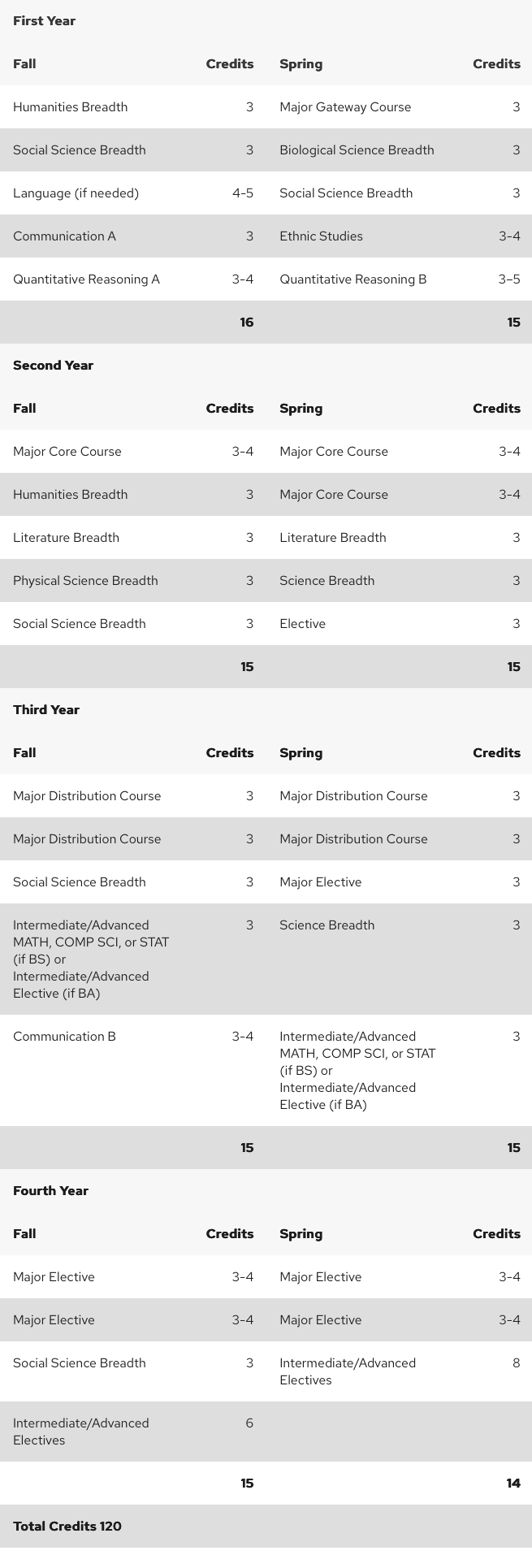Overview
The Four-Year Plan is intended to demonstrate that the degree and major can be completed in four years, given full-time enrollment, adequate grades, and assuming no advanced standing credit. The plan depicts one way, and not the only way to complete the program. Students are encouraged to use DARS and consult their advisor to craft a Four-Year Plan for their personal situation and goals.
Some programs have Three-Year Plans. These plans are optional and intended to demonstrate that the program could be completed in three academic years, if a student enters UW–Madison with advanced standing that meets some degree and major requirements. Departments interested in creating a Three-Year Plan should consult AIM for assistance.
Creating a Four-Year Plan
Create a Four-Year Plan that is consistent with the requirements of the degree and major. Each Four-Year Plan must include:
- University General Education requirements (UGER),
- L&S BA and BS degree requirements,
- major-specific requirements, and
- the standard L&S statement explaining the purpose of the Four-Year Plan. This statement is added by the College at its stage of Lumen workflow.
Where possible, departments are encouraged to include required major courses that meet UGER or BA/BS requirements in their plan.
- Guidance
- University General Education Requirements
- L&S Degree Requirements
- Sample L&S Four-Year Plan
Guidance
Create a plan that represents how and when students are likely to take courses that meet the requirements of your program in eight semesters.
- Include eight semesters of 14-16 credits per semester. Exclude summers.
- The total credits must sum to 120 credits.
- Label years as First Year, Second Year, Third Year, and Fourth Year. Do not use class standing terms like Freshman, Sophomore, Junior or Senior.
- Use specific courses in the plan when there are fewer than three that could complete a requirement. When there are more, state the requirement name (e.g., Advanced Major course).
- When a required major course can also meet a University General Education (UGER) and/or L&S degree requirement, list that course and enclose the UGER or degree requirement in parentheses.
- Focus on your program and avoid referring to other majors and certificates that are commonly combined with the major.
- Limit use of footnotes by referring to the Requirements page for uncommon situations or auxiliary information.
- Use approved terminology for University General Education Requirements and L&S degree requirements. Send questions about terminology to AIM.
University General Education Requirements (UGER)
Where possible, highlight courses in the major that meet UGER requirements for Communication B, Ethnic Studies, and Quantitative Reasoning B.
Standard Language
Use this terminology or include specific UGER major courses where possible:
| Requirement | Terminology | Year & Term | Note |
|---|---|---|---|
| Communication Part A | Communication A | First, either term | Include one instance. |
| Communication Part B | Communication B | First, Spring or Second, either term | Include one instance. |
| Quantitative Reasoning Part A | Quantitative Reasoning A | First, Fall | Include one instance. |
| Quantitative Reasoning Part B | Quantitative Reasoning B | First, Spring | Include one instance. |
| Ethnic Studies | Ethnic Studies | First, either term | Include one instance. |
L&S Degree Requirements
L&S degree requirements must be included in the plan. Like with UGER, include any required major courses that also meet degree requirements, where possible.
Standard Language
| Requirement | BA Terminology | BS Terminology | Year & Term | Note |
|---|---|---|---|---|
| Language | Language (if needed) | First, Fall | Include one instance. | |
| Mathematics | N/A | Intermediate/Advanced MATH, COMP SCI, or STAT | Second, Third, or Fourth, either term | Pair with Intermediate/Advanced Elective(s) for BA students. |
| Breadth: Humanities | Humanities Breadth | First, Second, or Third, either term | Include two instances totaling 6 credits. | |
| Breadth: Literature | Literature Breadth | First, Second, or Third, either term | Include two instances totaling 6 credits. | |
| Breadth: Natural Sciences | Biological Science Breadth | First or Second, either term | Include one instance of at least 3 credits. | |
| Physical Science Breadth | First or Second, either term | Include one instance of at least 3 credits. | ||
| Science Breadth | Second or Third, either term | Include two instances totaling 6 credits. | ||
| Breadth: Social Sciences | Social Science Breadth | First, Second, or Third, either term | Include three or four instances totaling 12 credits. | |
| Electives to reach 120 Degree Credits | Elective(s) | Second, either term (if needed) | Include only one instance per term regardless of the credits prescribed. | |
| Electives to reach 120 Degree Credits | Intermediate/Advanced Elective(s) | Third or Fourth, either term | Include only one instance per term regardless of the credits prescribed. | |
Sample L&S Four-Year Plan
The program represented here is a 39 credit undergraduate major in L&S.

The Major Gateway Course in Spring of the First Year represents the student’s initial course in the major. Depending on the program structure, this could be a specific course, a pairing of three or fewer courses, or a cognate term (e.g., “Introductory Course”) used as a placeholder.
Majors often have a core of courses that are foundational to work in the discipline. The entries for Major Core Course represent this foundation.
Some programs require students to take a number of courses that engage specific areas, concepts, topics, or themes. The entries for Major Distribution Course represents this type of requirement.
Some programs include electives to reach the minimum total credits needed to complete the curriculum. The entries for Major Elective help a student plan to distribute this work and attain this minimum credit total as they go deeper in their study within the program.